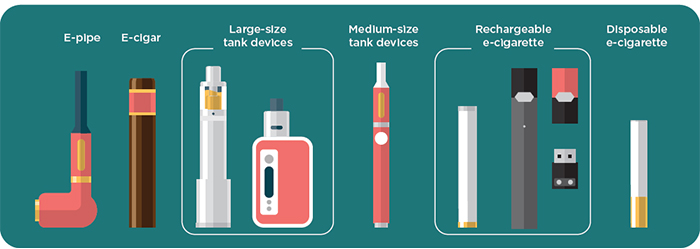Facts about Vaping and E-Cigarettes
Facts About Vaporizers and E-Cigarettes
Over the last few years, we have seen an increase in the use of vaporizers and e-cigarettes by teens and young adults. In 2015, more than 3 million youth in middle and high school, including about 1 of every 6 high school students, used e-cigarettes in the past month. E-cigarettes typically contain nicotine derived from tobacco. This means that teens and young adults are using the drug nicotine more often, along with other chemicals and drugs that can be put into the vaporizers.
What are e-cigarettes/vaporizers?
E-cigarettes are electronic devices that heat a liquid and produce an aerosol, or mix of small particles in the air.
E-cigarettes come in many shapes and sizes. Most have a battery, a heating element, and a place to hold a liquid.
Some e-cigarettes look like regular cigarettes, cigars, or pipes. Some look like USB flash drives, pens, and other everyday items. Larger devices such as tank systems, or “mods,” do not look like other tobacco products.
E-cigarettes are known by many different names. They are sometimes called “e-cigs,” “e-hookahs,” “mods,” “vape pens,” “vapes,” “tank systems,” and “electronic nicotine delivery systems (ENDS).”
Using an e-cigarette is sometimes called “vaping” or “JUULing.”

What is JUUL?
JUUL is a brand of e-cigarette that is shaped like a USB flash drive. Like other e-cigarettes, JUUL is a battery-powered device that heats a nicotine-containing liquid to produce an aerosol that is inhaled.
All JUUL e-cigarettes have a high level of nicotine. According to the manufacturer, a single JUUL pod contains as much nicotine as a pack of 20 regular cigarettes.2
News outlets and social media sites report widespread use of JUUL by students in schools, including classrooms and bathrooms.
Although JUUL is currently the top-selling e-cigarette brand in the United States, other companies sell e-cigarettes that look like USB flash drives. Examples include the MarkTen Elite, a nicotine delivery device, and the PAX Era, a marijuana delivery device that looks like JUUL.
Additional information about USB-shaped e-cigarettes and actions that parents, educators, and health care providers can take to protect kids is available at CDC’s Infographic
Health Risks of Vaping
Why is Nicotine Unsafe for Kids, Teens, and Young Adults?
Most e-cigarettes contain nicotine—the addictive drug in regular cigarettes, cigars, and other tobacco products.
Nicotine can harm the developing adolescent brain.1 The brain keeps developing until about age 25.
Using nicotine in adolescence can harm the parts of the brain that control attention, learning, mood, and impulse control.1
Each time a new memory is created or a new skill is learned, stronger connections – or synapses – are built between brain cells. Young people’s brains build synapses faster than adult brains. Nicotine changes the way these synapses are formed.
Using nicotine in adolescence may also increase risk for future addiction to other drugs.
No matter how it's delivered, nicotine is harmful to youth and young adults. E-cigarettes typically contain nicotine as well as other chemicals that are known to damage health. The U. S. Department of Health and Human Services created the resource page Know the Risks: E-cigarettes & Young People through a partnership with the Office of the U. S. Surgeon General and the Centers for Disease Control and Prevention, Office on Smoking and Health. The resource provides the following information on the risks associated with vaporizer use for teens and young adults based on the U. S. Surgeon General Report 2016.
Risks of Vaping
E-cigarette use poses a significant – and avoidable – health risk to young people in the United States. Besides increasing the possibility of addiction and long-term harm to brain development and respiratory health, e-cigarette use is associated with the use of other tobacco products that can do even more damage to the body. Even breathing e-cigarette aerosol that someone else has exhaled poses potential health risks.
Brain Risks - The part of the brain that is responsible for decision making and impulse control is not yet fully developed during adolescence. Young people are more likely to take risks with their health and safety, including use of nicotine and other drugs. Youth and young adults are also uniquely at risk for long-term, long-lasting effects of exposing their developing brains to nicotine. These risks include nicotine addiction, mood disorders, and permanent lowering of impulse control. Nicotine also changes the way synapses are formed, which can harm the parts of the brain that control attention and learning.
Addiction - How does the nicotine in e-cigarettes affect the brain? Until about age 25, the brain is still growing. Each time a new memory is created or a new skill is learned, stronger connections – or synapses – are built between brain cells. Young people's brains build synapses faster than adult brains. Because addiction is a form of learning, adolescents can get addicted more easily than adults can. The nicotine in e-cigarettes and other tobacco products can also prime the adolescent brain for addiction to other drugs such as cocaine.
Behavior Risks - E-cigarette use among youth and young adults is strongly linked to the use of other tobacco products, such as regular cigarettes, cigars, hookah, and smokeless tobacco. Some evidence suggests that e-cigarette use is linked to alcohol use and other substance use, such as marijuana. In addition, certain e-cigarette products can be used to deliver other drugs like marijuana.
Use of Two or More Tobacco Products - Some people have suggested that use of e-cigarettes by young people might "protect" them from using cigarettes. There is no evidence to support this claim. Some studies show that non-smoking youth who use e-cigarettes are more likely to try conventional cigarettes in the future than non-smoking youth who do not use e-cigarettes. In addition, among high school students and young adults who use tobacco, more use both e-cigarettes and burned tobacco products than e-cigarettes alone. Burned tobacco products like cigarettes are responsible for the overwhelming majority of tobacco-related deaths and disease in the United States.
Aerosol and Other Risks - The aerosol from e-cigarettes is not harmless. It can contain harmful and potentially harmful chemicals, including nicotine; ultrafine particles that can be inhaled deep into the lungs; flavoring such diacetyl, a chemical linked to a serious lung disease; volatile organic compounds such as benzene, which is found in car exhaust; and heavy metals, such as nickel, tin, and lead. Scientists are still working to understand more fully the health effects and harmful doses of e-cigarette contents when they are heated and turned into an aerosol, both for active users who inhale from a device and for those who are exposed to the aerosol secondhand. Another risk to consider involves defective e-cigarette batteries that have been known to cause fires and explosions, some of which have resulted in serious injuries. Most of the explosions happened when the e-cigarette batteries were being charged. (website)
Parent Conversation Points - Talk to Your Child
Please review the Talk with Your Teen About E-cigarettes: A Tip Sheet for Parents by clicking on the link. This sheet gives great information about vaping, as well as how to start the conversation with your child and answer their questions. The more resources we have the better we are able to speak with our kids and help them avoid the risks associated with vaping. There are e-cigarette devices out now that look like USB devices that could be plugged into a computer. Companies are marketing these products towards kids by making them easy to conceal from their parents and school. What are some things parents can do to help prevent children from using e-cigarettes?
Set a good example by being tobacco-free. If you use tobacco, it is never too late to quit. For free help, visit smoke free or call 1-800-QUIT-NOW.
Talk to your child or teen about why e-cigarettes are harmful for them. It is never too late.
Get the Talk With Your Teen About E-cigarettes tip sheet for parents. Start the conversation early with children about why e-cigarettes are harmful for them.
Let your child know that you want them to stay away from all tobacco products, including e-cigarettes, because they are not safe for them. Seek help and get involved.
Set up an appointment with your child’s health care provider so that they can hear from a medical professional about the health risks of tobacco products, including e-cigarettes.
Speak with your child’s teacher and school administrator about enforcement of tobacco-free school grounds policies and tobacco prevention curriculum.
Encourage your child to learn the facts and get tips for quitting tobacco products at teen smoke free.
We encourage you to speak with your students about the dangers of vaping and the potential consequences that are associated with it. Please reach out if you have any questions or need assistance.
